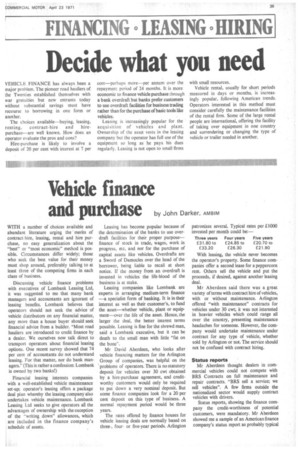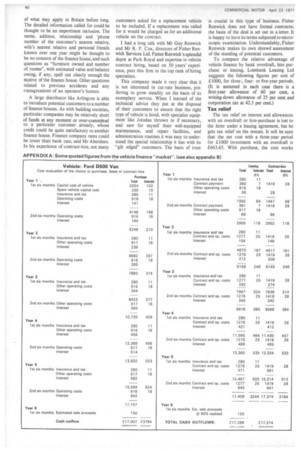Vehicle finance and purchase
Page 41

Page 42

Page 43

If you've noticed an error in this article please click here to report it so we can fix it.
by John Darker, AMBIM WITH a number of choices available and abundant literature urging the ' merits of contract-hire, leasing, rental and hire purchase, no easy generalization about the "best" or "most economic" method is possible. Circumstances differ widely; those who seek the best value for their money must shop around, preferably talking to at least three of the competing firms in each class of business.
Discussing vehicle finance problems with executives of Lombank Leasing Ltd, it was suggested to me that many bank managers and accountants are ignorant of leasing benefits. Lombank believes that operators should not seek the advice of vehicle distributors on any financial matter, any more than a house buyer should seek financial advice from a builder. "Most road hauliers are introduced to credit finance by a dealer. We ourselves now talk direct to transport operators about financial leasing options. One recent survey showed that 74 per cent of accountants do not understand leasing. For that matter, nor do bank managers." (This is rather a confession; Lombank is owned by two banks!)
Financial leasing interests companies with a well-established vehicle maintenance set-up; operator's leasing offers a package deal plan whereby the leasing company also undertakes vehicle maintenance. Lombank Leasing Ltd seeks to give operators all the advantages of ownership with the exception of the -writing down" allowances, which are included in the finance company's schedule of assets.
Leasing has become popular because of the determination of the banks to use overdraft facilities for their proper purpose— finance of stock in trade, wages, work in progress, etc, and not for the purchase of capital assets like vehicles. Overdrafts are a Sword of Damocles over the head of the borrower, being liable to recall at short notice. If the money from an overdraft is invested in vehicles the life-blood of the business is at stake.
Leasing companies like Lombank are experts in arranging medium-term finance —a specialist form of banking. It is in their interest as well as their customer's, to fund the asset—whether vehicle, plant or equipment—over the life of the asset. Hence, the larger the deal, the better interest terms possible. Leasing is fine for the shrewd man, said a Lornbank executive, but it can be death to the small man with little "fat on the bone".
Mr David Aberdeen, who looks after vehicle financing matters for the Arlington Group of companies, was helpful on the problems of operators. There is no statutory deposit for vehicles over 30 cwt obtained by a hire-purchase agreement, and creditworthy customers would only be required to put down a very nominal deposit. But some finance companies look for a 20 per cent deposit on this type of business. A normal repayment period would be three years.
The rates offered by finance houses for vehicle leasing deals are normally based on three-, fouror five-year periods. Arlington
patronizes several. Typical rates per £1000 invested per month could be— Three years Four years Five years
£31.80 to £24.85 to £20.70 to £33.20 £26.30 £21.90 With leasing, the vehicle never becomes the operator's property. Some finance companies offer a second lease for a peppercorn rent. Others sell the vehicle and put the proceeds, if desired, against another leasing deal.
Mr Aberdeen said there was a great variety of terms with contract hire of vehicles, with or without maintenance. Arlington offered "with maintenance" contracts for vehicles under 30 cwt; it was not interested in heavier vehicles which could range all over the country, presenting maintenance headaches for someone. However, the company would undertake maintenance under contract for any type of vehicle, whether sold by Arlington or not. The service should not be confused with contract hiring.
Status reports Mr Aberdeen thought dealers in commercial vehicles could not compete with BRS Contracts on full maintenance and repair contracts. "BRS sell a service; we sell vehicles". A few firms outside the nationalized sector would supply contract vehicles with drivers.
Status reports, showing the finance company the credit-worthiness of potential customers, were mandatory. Mr Aberdeen showed me a sample of an American finance company's status report as probably typical of what may apply in Britain before long. The detailed information called for could be thought to be an impertinent intrusion. The name, address, relationship and 'phone number of the customer's nearest relative, wife's nearest relative and personal friends known over one year might be thought to be no concern of the finance house, and such questions as "furniture owned and number of rooms", with estimated value and balance owing, if any, spell out clearly enough the motive of the finance house. Other questions related to previous accidents and any transgressions of an operator's licence.
A large distributor like Arlington is able to introduce potential customers to a number of finance houses. As with building societies, particular companies may be relatively short of funds at any moment or over-committed to a particular customer already, whose credit could be quite satisfactory to another finance house. Finance company rates could be lower than bank rate, said Mr Aberdeen. In his experience of contract-hire, not many customers asked for a replacement vehicle to be included. If a replacement was called for it would be charged as for an additional vehicle on the contract.
I had a long talk with Mr Guy Renwick and Mr R. F. Cox, directors of Fisher Renwick Services Ltd. Fisher Renwick's splendid depot at Park Royal and expertise in vehicle contract hiring, based on 50 years' experience, puts this firm in the top rank of hiring specialists.
This company made it very clear that it is not interested in cut-rate business, preferring to grow steadily on the basis of its exemplary service. When I learned of the technical advice they put at the disposal of their customers to ensure that the right type of vehicle is hired, with specialist equipment like Jolodas thrown in if necessary, and saw for myself their well-equipped maintenance, and repair facilities, and administration routines it was easy to understand the special relationship it has with its "gilt edged" customers. The basis of trust is crucial in this type of business. Fisher Renwick does not have formal contracts; the basis of the deal is set out in a letter. It is happy to have its terms subjected to microscopic examination. Understandably, Fisher Renwick makes its own shrewd assessment of the standing of potential customers.
To compare the relative advantage of vehicle finance by bank overdraft, hire purchase or leasing, Lombank Leasing Ltd suggests the following figures per unit of £1000, for three-, fouror five-year periods. (It is assumed in each case there is a first-year allowance of 60 per cent, a writing-down allowance of 25 per cent and corporation tax at 42.5 per cent.) Tax relief The tax relief on interest and allowances with an overdraft or hire-purchase is lost to the hirer under a leasing agreement, but he gets tax relief on the rentals. It will be seen that the net cost with a three-year period for £1000 investment with an overdraft is £663.65. With purchase, the cost works out at £692.30, and with leasing, £672.75.
The four-year-term figures show that leasing is only marginally more expensive than an overdraft facility. Net hire-purchse costs at £731.40 are appreciably more than either bank overdraft or leasing. The same trend is reflected in the five-year figures.
Some interesting figures produced by an up-and-coming contract hire company relate to a five-year-cost comparison for vehicle finance by cash, leasing or contract-hire. Total cost to customer of a Ford D500 van, over a five-year period, works out at £17,007 (purchase); £17,289 (leasing); and £17,374 (contract-hire). Included in these sums is interest charges, respectively, £3784, £3244, and £3184.
However, on a discounted cash flow (DCF) basis, the net dash outflow is £12,090 (purchase); £12,520 (leasing); and £12,650 (contract-hire). It has been assumed that (a) the customer is chargeable to corporation tax; (b) that for purposes of corporation tax assessments the contract commences and terminates mid-way through a corporation tax accounting year and (c) the rate for corporation tax is 421per cent. (Corporation tax was reduced in the recent Budget.) Assuming a discount factor of 9 per cent the net present values (NPV) of the cash flows in the above quoted example is as follows: Purchase, £10,429; lease £10,397; contract-hire, £10,432. The average business man is certainly helped by a knowledgeable management accountant in deciding his vehicle finance policy when there is so little in it-a mere £35 in some £10,000.
The basis of this comparison of operating costs, when the vehicle is purchased or leased, rests on the 1970 Commercial Motor Tables of Operating Costs, updated for known cost increases. Additionally, a fleet discount of 15 per cent has been assumed in respect of the initial capital cost.
Additional benefits not related directly to cost accrue to a contract hire customer. He is able to utilize his capital within his own company and provide a higher return on capital than is required by the contract-hire company; the customer's transport costs can be forecast in advance, enabling its pricing structure and corporate plans to be more readily ascertained; and the management effort and expense related to the complexities of current transport legislation is absorbed by the contract-hire company.
Of the taxation element, with contract hire, the owning company obtains the capital allowances on vehicles, 60 per cent of their cost in the year of expenditure and in subsequent years 25 per cent reducing balance. (Allowances are effective in tax saving 12 months after the end of the financial year in which allowance is taken, assuming December 31 year end.) The customer obtains tax allowance on the full amount of the hire charge plus running costs.
A similar position obtains with leasing if the customer company takes risk of residual value at end of lease to contract-hire.




























































































































